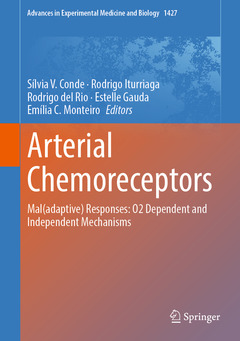Description
Arterial Chemoreceptors, 1st ed. 2023
Mal(adaptive) Responses: O2 Dependent and Independent Mechanisms
Advances in Experimental Medicine and Biology Series, Vol. 1427
Coordinators: Conde Sílvia V., Iturriaga Rodrigo, del Rio Rodrigo, Gauda Estelle, Monteiro Emília C.
Language: English
Subjects for Arterial Chemoreceptors:
Keywords
Hypoxia; Hypercapnia; Metabolism; O2 sensing; Hypertension; Chronic heart failure
210 p. · 17.8x25.4 cm · Hardback
Description
/li>Contents
/li>Biography
/li>
The book will contain reviews and brief research articles from the participants attending the International Society for Arterial Chemoreception (ISAC) meeting, to be held in Lisbon in Portugal in June/July 2020. Since ISAC was first established, almost 70 years ago, many advances in the classical field of arterial O2, CO2 and pH sensing have been achieved but the most impressive ones are probably related to the non-canonical roles of the carotid body, as its involvement in sympatho-mediated diseases. Over the recent years, the carotid body field has gained attention with the findings that carotid body dysfunction is associated with the development/maintenance of highly prevalent diseases from cardio-metabolic diseases to asthma. Knowing that most of the patients with these pathologies lack long-term disease control, it is imperative to define new pathophysiological mechanisms aiming to find new therapeutic targets for treatment and prevention. This book will cover a broad range of topics related, not only with the fundamental knowledge of the mechanisms related with the chemical sensing in the carotid body, but also with the adaptive and mal-adaptive responses of arterial chemoreceptors to O2-dependent and O2-independent mechanisms, namely with their impact on respiratory, cardiovascular, and metabolic homeostasis in healthy and disease conditions. This volume will be required text for all the researchers in the field of arterial chemoreceptors and will provide a valuable reference source for years to come.
Dr. Silvia V. Conde is Professor of Pharmacology and Neuroscience and Principal Investigator at NOVA Medical School (NMS) . She graduated in Biochemistry in 2000 and has an Advanced Specialization Diploma in Physiology in 2005. As a PhD student under supervision of Prof. C. Gonzalez in Valladolid (Spain) and Emilia Monteiro (Portugal), she tried to understand how cells and the body respond to the lack of O2, through the study of the physiology of the carotid body. She pursued her PhD in Pharmacology from both the New University of Lisbon (Portugal) and the University of Valladolid (Spain) in 2007. Afterwards, she realized that for her the most exciting research involves trying to understand the pathophysiological alterations in the carotid body and in autonomic nervous system function that are in the genesis of cardiometabolic and respiratory Human diseases. As a PI, she developed a new line of research on the carotid body (CB) and dysmetabolism, which is based on the pioneering idea that the CB controls glucose homeostasis. She is dedicated to the characterization of pathophysiological biosignals, disease signatures and fingerprints that will allow the identification of targets for therapy, particularly bioelectronic targets, as her group recently described that high frequency electrical stimulation of carotid sinus nerve restores insulin sensitivity and glucose homeostasis in type 2 diabetes models. Her research in this field originated 2 patents, being one already licensed.
In 2009 she was awarded with the L’Oreal Medals Honor for Women in Science Portugal and since then her group won several prizes from the Portuguese Society of Diabetes and from the Pulido Valente Foundation. Silvia V. Conde lab is funded by grants from the Portuguese Funding Agency (Fundação para a Ciência e Tecnologia) and from Galvani Bioelectronics.
Dr. Rodrigo Iturriaga obtained the degree of Doctor in Physiological Sciences, at the P. Catholic University of C
These books may interest you

The Arterial Chemoreceptors 316.49 €



